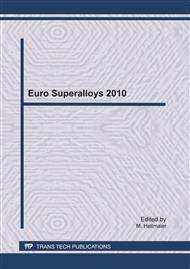p.234
p.241
p.247
p.253
p.259
p.265
p.271
p.277
p.283
Effect of Microstructure on High-Temperature Mechanical Behavior of Nickel-Base Superalloys for Turbine Disc Applications
Abstract:
The objective of this work was to establish relationships between alloy microstructure and high temperature mechanical properties such as strength, creep, and creep crack growth in Nickel-base powder metallurgy superalloys. Systematic variations of super solvus heat-treatments generated test material from three next-generation turbine disc alloys. Quantification of key microstructural features such as γ’ distribution and morphology and grain boundary serrations was coupled with mechanical testing results in order to optimize microstructure for operating conditions specific to the bore region.
Info:
Periodical:
Pages:
259-264
Citation:
Online since:
July 2011
Authors:
Keywords:
Permissions:
Share:
Citation:


